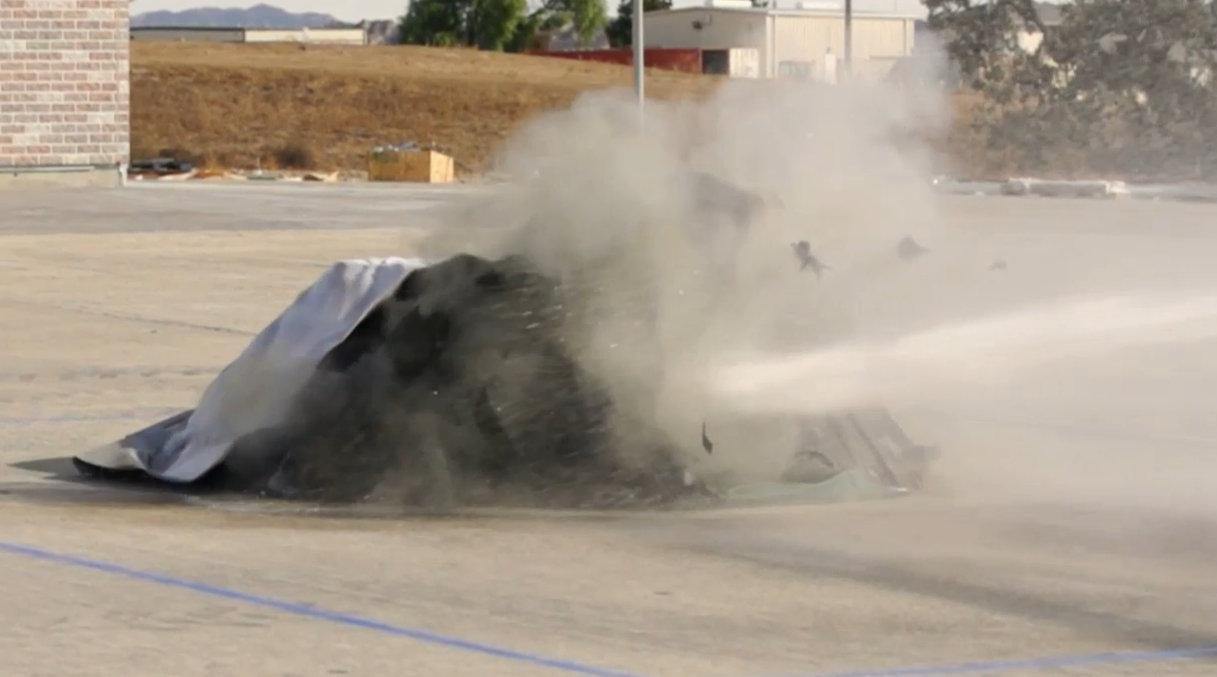Every Friday, Andrew Stroup and Corey Fleischer will recap the latest episode of “The Big Brain Theory: Pure Genius.” Stroup and Fleischer are the two Maryland contestants competing on the new Discovery Channel show that airs Wednesdays at 10 p.m. Stroup and Fleischer hold weekly viewing parties starting at 9 p.m. at PBR Baltimore.
See last week’s summary here.
Episode 3 summary:
In Episode 3, each team had to design and deliver a shelter to protect against three elements, taken to the extreme: wind, fire and water. Each team was given three days and $4,000 dollars to complete this task.
After all was said and done, BLUE team failed and Allison was the contestant eliminated by the judges. A close call for me, but I fortunately live to see another week. Allison joins Joe (Challenge 1, Episode 1) and Joel (Challenge 2, Episode 2) of the eliminated contestants in the running for the “wild card,” a chance to come back and compete for the grand prize, selected by the judges during a later episode.
If you missed the episode, you can watch it here.
Episode 3 in-depth coverage (for those interested in the Blue Team’s design, and the behind-the-scenes “dirt”):
THE EXTRA RULES: So … I’d first like to caveat this section with the fact that Kal [the show’s host] and the judges did not include a couple of critical pieces of information until after the teams were selected: the entire design had to fit inside a medium-sized military duffel bag AND we had to be able to protect the person inside the shelter from all directions. The only term we heard during the blueprint challenge was “portable.”
MY DESIGN: I proposed a trailer-sized shelter on wheels with hydraulic outriggers and a hydraulic extendable front “shield,” in a half sphere shape, to deflect the elements and reduce the amount of direct force exerted on the shelter. Clearly, I have a drastic difference in definition of “portable” and this was not going to be the winning design. More importantly, I was OK with that (HINT: STRATEGY, see below).
BLUE TEAM DESIGN: I was selected to be part of Allison’s team, joining Tom, Eric and Joel. At this point, I hadn’t worked with any of them, except Eric, and was looking forward to a change of scenery from the constant yelling (*cough* Dan). We ended up with a “T.U.R.T.L.E.” design, which included an aerospace grade structure, wrapped with heat-resistant material and supported by an inner tube for support and protection against the water blast. NOTE: We would have gone with Allison’s original design, but because it was designed for only one direction (and we had to address a 360-degree threat; see above for “hidden” rules) we had to modify and rethink our design to meet the new design parameters.
A CAVEAT: To clear the air, Joel was the originator behind the inner tube idea. So much so that it came to a vote among the group regarding whether to use it. His original idea (before the turtle shell design was finalized) was to literally procure an emergency-at-sea inflatable. The use of the inflatable was decided to be used after the turtle shell design was underway and I took on the responsibility to make sure it was executed.
INNER TUBE/CO2: With the limited resources and time we had left to implement the inner tube design, we were only able to find CO2 tanks (required three of them) of the right size from a local paintball store. We also had to source and fabricate special fittings to be able to transfer the CO2 from the canisters to the inflatable in an efficient manner that wouldn’t choke the flow. I actually spent a decent amount of time doing the math, researching common practices and figuring out what combination of makeshift fittings and valves we could use, acquire and integrate within the time provided and budget.
We tried procuring O2 (high-pressurized air), but between air and gas, medical supply stores and the paintball store, none were to be had that yielded the results we needed or in the size/quantity required. A lot of people asked why CO2 was beyond availability, and that answer is fairly simple. Let’s do some easy chemistry: O2 feeds the fire and CO2 would suppress it (ex: fire extinguisher) in a worse-case scenario. We used what was available and I have no regrets with the choices the team made to complete the build.
DELAYS: This is the first time the show revealed another layer of the challenges: procurement of material. Due to unexpected extended lead times, we weren’t able to receive the material for the frame until the end of Day 2 (out of 3). This put a huge strain on the team and our sewing in overtime because we needed hard dimensions and fitting for the protective fabric shell.
CHALLENGE: Ultimately, we survived the wind, but because the edges weren’t secured enough, the fire was able to creep in and catch the inside canvas material on fire and consequentially the inner tube. Although the CO2 suppressed the fire, the side effect was expediting the removal of oxygen. HOWEVER, if the CO2 wouldn’t have put out the fire, all the oxygen would have been consumed in the internal fire anyways, likely causing the temperature inside to be even higher and burning down the entire design.
Because we failed the fire test and lost the inner tube structure our design was unable to withstand the impact of the water cannon, which was the whole point of adding the inner tube.
WHAT YOU DIDN’T SEE: Because the challenge day was windy, WET design firm (who provided the evil devices) was unable to replicate the fire intensity on BLUE team’s design onto RED team’s design (literally not even touching their shelter) during the first attempt. So to keep it “fair,” they put both designs under the FIRE test THREE times. BLUE team’s design was directly hit by fire THREE times successfully, but RED team’s design was only hit once out of the three due to wind. This obviously didn’t help our design as the fire kept creeping inside and causing more issues.
STEPPING UP: When it came down to who would assemble the device, the decision was based solely on size and strength. Although any one of the team members was willing to be the one that put together the shelter, I had the right combo of size and strength to assemble the design. More importantly, I had no problem and was willing to step up for the team.
BEHIND THE SCENES: What you don’t see is that we spent all night before the competition practicing the assembly of the design in preparation for the challenge day. Often leading to anger and frustration, we were finally able to come up with a method to complete the assembly within the five minutes. The design was literally a jigsaw puzzle, requiring a combo of finesse and brute strength to assemble the design.
RESULTS: The breakdown between both teams came down to numbers. Although the BLUE team had less g-forces from the water cannon, both teams exceeded the survivable g-force from a blast, equating in failure for both teams in this category. The ultimate decision was based on oxygen levels inside the shelter, where the BLUE team ultimately fell short (not far behind RED team).
VOTING: Once again, the things you don’t see is that each contestant was asked three questions: 1) why should you stay? 2) who was the strongest team member? and 3) who was the the weakest? I’m honored Allison picked me as the strongest. Her justification was that I stepped up to fill in any gaps in skill sets throughout the challenge to make sure we delivered a solution. On the flip side, what you didn’t see was that I picked Allison as the weakest. The only reason why I chose her was because I truly enjoyed working with all of them and would have to split hairs to make a real decision on performance. Ultimately, I stood by my belief that a captain goes down with the ship.
Although the inner tube idea was Joel’s idea, when asked on the chopping block whose responsibility was the inner tube design, I quickly spoke up. Since Joel was already eliminated, I did not feel like it was appropriate to call Joel out as the source of the idea because passing the blame on someone who wasn’t in the game would have been disingenuous in my eyes. I had no problem taking responsibility in attempting to execute the feature and hold no regrets.
A good engineer takes credit for his success. A great engineer accepts failure and grows from it.
STRATEGY: See a trend here? Two of the three team leaders have been eliminated. The biggest problem I realized was that the team leaders weren’t judged on a separate metric for their leadership skills and only what they delivered, making it extra hard when you’re on the chopping block. I haven’t won a challenge yet, and it’s pretty apparent by now, I’m in no rush.
Join the conversation!
Find news, events, jobs and people who share your interests on Technical.ly's open community Slack

Baltimore daily roundup: Real estate deal in the Peninsula; Missing $100M nitrile glove factory; Dirt bike clampdown

Baltimore daily roundup: Gen AI's software dev skills; UpSurge Tech Ecosystem Report; MD service year program

Baltimore daily roundup: Mayoral candidates talk tech and biz; a guide to greentech vocabulary; a Dutch delegation's visit

